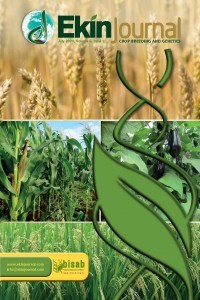The Study of the Sum of Active Temperatures Affecting Autumn Bread (Triticum aestivum L.) Wheat Under Dry Rainfed Conditions
The Study of the Sum of Active Temperatures Affecting Autumn Bread (Triticum aestivum L.) Wheat Under Dry Rainfed Conditions
The sum of active temperatures affecting 21 autumn bread wheat genotypes with contrasting morphophysiological properties
during the flowering and grain filling phases after earing has been studied under dry rainfed conditions in 2013-2014, during
vegetation periods characterized by different hydrometeorological parameters. The functioning period of flag leaves in
Murov 2, Gyrmyzy gul-1 and Zirva 85 genotypes appeared to be longest and they had higher sums of active temperatures
(SAT) compared with other varieties during both years. Qyzyl bugda, Layagatli-80 and 12 IWWYT № 6 varieties had
quite high higher sums of active temperatures values in 2013, but they showed lower results under unfavorable climatic
conditions in 2014. There were a positive correlation between SAT and productivity at r=0.55**, and a negative correlation
between earing dates and higher sums of active temperatures at r=-0.41** during both years.
Keywords:
Triticum aestivum L., morphophysiological properties, productivity dry rainfed conditions,
___
- Aliyev JA. Physiological bases of wheat breeding tolerant to water stress. Proceedings of the 6th International Wheat Conference, Budapest, Hungary, 2000. In: Wheat in a Global Environment ( Z. Bedo and Lang L., eds.) Kluwer Academic Publisters, Dordrecht-Boston-London 9; p 693-698.
- ISSN: 2149-1275
- Yayın Aralığı: Yılda 2 Sayı
- Başlangıç: 2015
- Yayıncı: Bitki Islahçıları Alt Birliği
